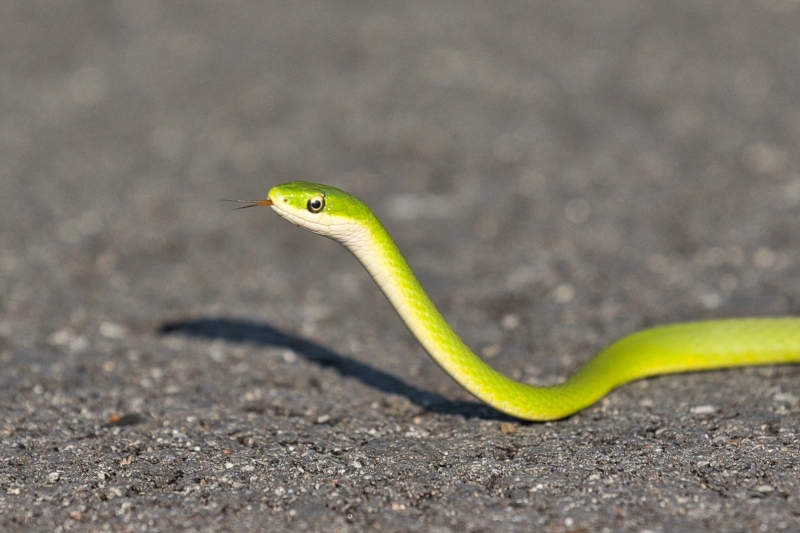While exploring the Sequoyah National Wildlife Refuge in Oklahoma, I was thrilled to encounter a Rough Green Snake slithering across the asphalt road. Its bright green color stood out vividly against the dark pavement, making it an irresistible subject for a photograph. I quickly pulled over, grabbed my Canon EOS 7D Mark II equipped with a Canon EF 100-400mm f/4.5-5.6L IS II lens, and set up for the shot.

Camera Settings and Technique
I shot in aperture priority mode to have control over the depth of field, allowing the background to blur slightly while keeping the snake in sharp focus. Here were the camera settings:
- Shooting Mode: Aperture Priority (AV)
- Shutter Speed: 1/2500 sec
- Aperture: f/5.6
- ISO: 800
- Exposure Compensation: -0.3 EV
The fast shutter speed of 1/2500 sec allowed me to capture the snake’s quick movements sharply. I used a -0.3 exposure compensation to avoid overexposure, given the bright sunlight reflecting off the asphalt. Handholding the camera provided flexibility to follow the snake’s motion as it crossed the road.
About the Rough Green Snake
Rough Green Snakes are slender, non-venomous reptiles found throughout the southeastern United States, including Oklahoma. Their bright green coloration provides excellent camouflage in foliage, making them difficult to spot when they are off the ground. These snakes typically measure between 22 and 32 inches in length, though some can reach up to 45 inches.
Rough Green Snakes primarily feed on soft-bodied insects like crickets and grasshoppers, as well as spiders, snails, and small amphibians. They are arboreal, spending much of their time in bushes and trees, where they hunt for prey. However, they sometimes descend to the ground to cross open areas or seek different food sources.
Reproduction and Life Cycle
Female Rough Green Snakes lay 2 to 12 elongated eggs in late spring or early summer (June or July), often in rotting logs or leaf litter. The eggs hatch in late summer (August or September), producing young snakes that measure around 7 to 8 inches. Juveniles share the same bright green coloration as adults, which helps them blend into their surroundings from a young age.
Tips for Photographing Reptiles
- Get Low to the Ground: Positioning the camera at the snake’s eye level provides a more engaging and intimate perspective.
- Use a Fast Shutter Speed: Snakes can move quickly, so a shutter speed of at least 1/1000 sec is recommended to capture sharp images.
- Maintain a Safe Distance: Although Rough Green Snakes are non-venomous, it’s always good practice to keep a respectful distance from any wildlife.
- Watch the Lighting: When shooting on bright surfaces like asphalt, consider using exposure compensation to prevent overexposure.
Sequoyah National Wildlife Refuge: A Reptile Haven
The Sequoyah National Wildlife Refuge is known for its diverse wildlife, including various reptile species like the Rough Green Snake. The refuge’s mix of wetlands, woodlands, and open fields provides an ideal habitat for many snakes. The abundance of insects and small prey supports a healthy population of Rough Green Snakes, making sightings like this possible.
Photographing this Rough Green Snake crossing the road was a special experience, not only because of the snake’s vibrant appearance but also because it highlighted the lesser-seen, but equally fascinating, wildlife at the refuge. Moments like these remind us of the incredible diversity of life that can be found when we take the time to observe the natural world around us.
